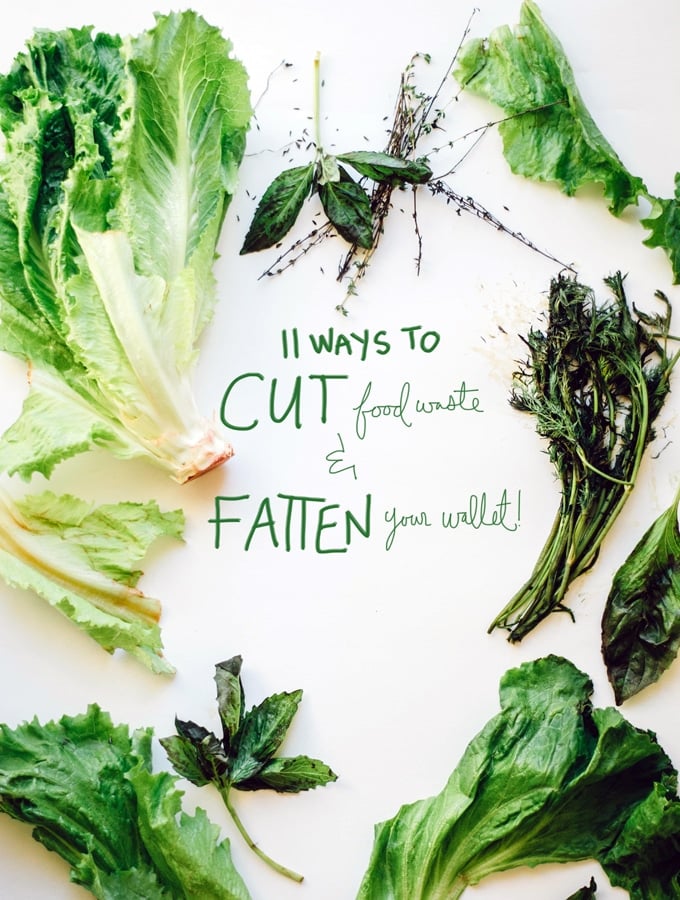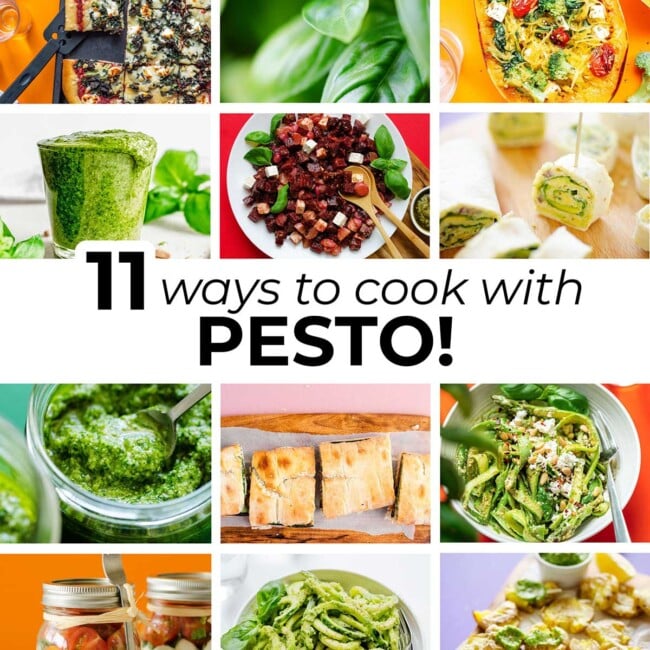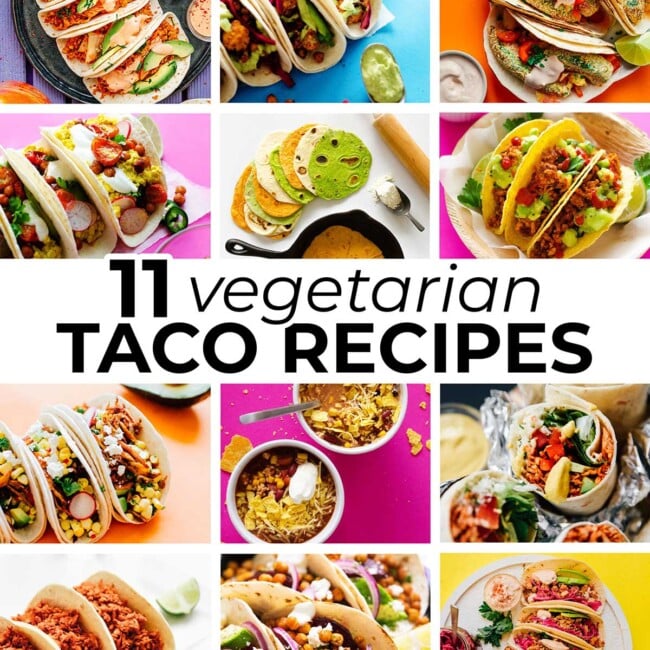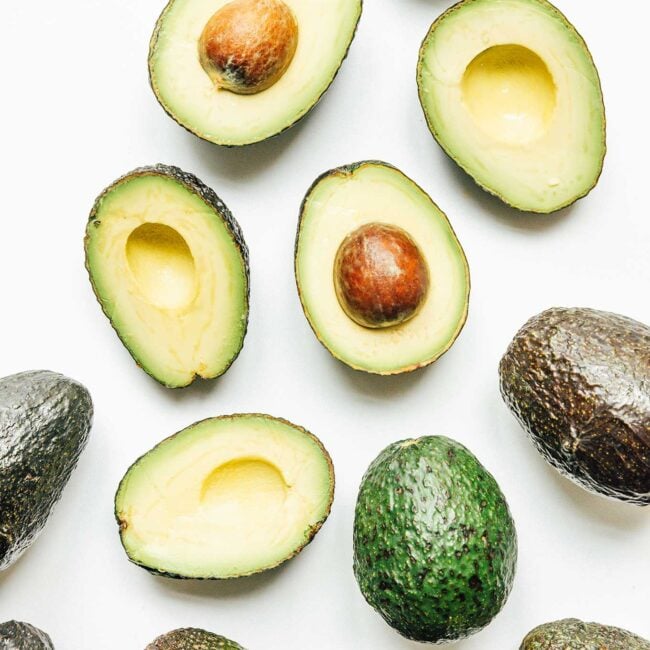I have a confession: having been cooking up a storm over the past few months as I delve into the world of food blogging, I’ve wasted a lot of food. I’m not proud of it. But I’m not alone. Americans throw away an average of 20 pounds of food each month, ⅓ of our food, totaling $516 in food waste per person each year. And while I would like to comfort myself and say “oh, it’s inevitable!”, it’s not. So here are 11 practical tips to help us reduce our food waste (and the wasted money that goes with it).
How to Reduce Food Waste When You Grocery Shop
1. Plan for the next week or so: Before you set out for the grocery, take a minute to think through a few recipes you’ll make over the next week. Aim for recipes with similar ingredients to prevent having half a tomato here and a rotting leftover cucumber there. You can also look through grocery stores flyers to find the weeks sales, then center a few meals around the sale items.
2. Make an adaptable list: Once you have a few recipes in mind, make a list of what you’ll need, taking into account what you already have at home. Keep in mind that cooking isn’t an exact science, and often times you can exchange something you already have at home for an ingredient called for in the recipe. This post has a few clever kitchen substitutes to prevent you from buying what you might not necessarily need.
3. Stick to the list: You’ve taken the time to make your list, stick to it! Impulse buys are often more expensive and less healthy. As you challenge yourself to stick to your list, tally up the cost of everything else you would have liked to buy. How much did you save in just one shopping trip?
4. Buy loose or bulk: The loose item and bulk bins are the most underrated sections of the grocery. If you just need two carrots, don’t buy a whole bag. If you need one cup of a specialty flour, head over to bulk bins and get just what you need.
How toReduce Food Waste When You Cook
5. Practice portion control: Portion control is a big control point when it comes to food waste. Large portions can either cause us to 1) not eat all of our food, resulting in a big fat pile of food waste, or 2) eat more than our bodies need, resulting in, well, a big fat waist. Portion off less than you’re comfortable with to start. When you’ve finished, consciously ask yourself if you’re still hungry. If you are, by all means eat! But by bringing satiety cues to the front of your brain, you can start to better understand what your body is asking for. Often times, your body needs a lot less than what you’re feeding it!
6. Don’t toss the scraps: In the case of many fruits and vegetables, we only eat a small edible portion. We throw away a lot of actually very edible “scraps”. Here are a few ideas for cooking with “scraps”:
- Cut melon rind (hard outer part removed) into small cubes and cook into stir fries, use to make jam, use as a substitute for cucumber in cucumber salad, or make a Watermelon Rind Smoothie!
- The green tops of carrots are edible! Use them to garnish soups or salads.
- Most veggie scraps can be thrown into a soup or stock to impart some serious flavors. Onion skins, leek greens, carrot peels, you name it! Throw it all in a cheesecloth and tie the cheesecloth off with string to create a infusing pillow of flavor that can be fished out prior to serving.
- Parmesan rinds can also be thrown into soups and stocks. Tastes amazing and takes your cooking to the “Italian grandmother” level.
- What did broccoli stalks ever do to you? Cook these up with just about anything (stirfry, soup, chopped and roasted, in salads) for a hefty dose of fiber and flavor without many calories.
Reduce Leftover Food Waste
7. First in, first out: Store your leftovers and perishables so that the oldest is to the front of your fridge or pantry. Aim to use the oldest things first to prevent them from going bad. Extra points if you label each container with the date it was made; memories, like mold, can be fuzzy.
8. Keep food fresher, longer: So often my food goes bad before little ole me can get around to eating it. Fortunately, there are a few tricks to keeping your food fresher for longer.
- Don’t store fruits and veggies together. Many fruits give off ethylene gas, a compound that speeds up the ripening (and decaying) process. Keep these fruits away from the slowly ripening vegetables.
- Leave these foods at room temperature: onions, bread, honey, bananas, basil, stone fruits (avocado, apple, melon, tomato)
- Refrigerate these foods: non-stone fruits (grapes, berries, peppers, citrus), almost all veggies (exception: potatoes, onions, garlic, winter squash)
- You can freeze these foods: breads and tortillas, ginger, garlic, chopped carrots or celery, flour, chips, non milk-based stocks and sauces, most pre-chopped fruits (for smoothies), homemade dough
- But you definitely should not freeze these foods: almost anything creamy (with the exception of plain milk; sour cream, yogurt, soft cheeses), fried foods, high moisture fruits (watermelon, citrus, apples), foods heavy in egg yolks
- Herbs. Wrap hardy herbs (those with woody stalks; thyme, rosemary etc) in a damp paper towel, wrap that in plastic wrap, and store in fridge. Treat tender herbs (everything else; basil, mint etc.) like a bouquet of flowers, in a jar with a bit of water.
- Leafy greens. Wrap greens in a dry paper towel, place in a perforated plastic bag (you can just punch a few holes in a bag that zips), and refrigerate.
9. Expiration dates are a suggestion: The “use-by” date you may see on foods is not the be-all end-all of freshness. With the exception of some infant foods, expiration dates are not federally regulated, and are instead simply the date the manufacturer predicts the food will be at its peak freshness. Don’t toss a food just because it has lived past this date. Use smell, sight, and taste to determine if a food is past its peak.
10. Use foods that are on their last leg:
- Use leftover tomatoes to make a fresh, homemade marinara.
- Soon-to-go-bad bread can be cut into squares, tossed with olive oil, salt, and whatever herbs or seasonings you’re feeling, then broiled in the oven until crispy to make homemade croutons. You can also grind stale bread into breadcrumbs and store in the freezer.
- Mix fresh herbs with olive oil and freeze in an ice cube tray. When you’re ready to use them, simply add a few cubes to a saute pan for a quick and tasty base to your dish.
- Puree older fruit to make a fruity compote for topping pancakes and toast, or throw it in a blender for a healthy fruit smoothie.
- Speaking of smoothies, go ahead and throw your older veggies in as well. Spinach, kale, cucumbers, beets, carrots, and many other vegetables offer a powerful health punch to a fruit smoothie.
- Get creative. Yesterday’s chicken dinner is today’s chicken salad. Leftover pizza? Peel off the cheesy top, stick it between two slices of bread, and grill yourself up a pizza panini.
11. Designate one or two days a week as “leftover nights”: In my house growing up, if mom wasn’t home in time for dinner we would have “Duby’s” nights, a combination of Dad + Luby’s, the cafeteria-style Texas chain restaurant. Duby’s nights included every leftover in our fridge (+ the occasional Hamburger Helper), and boy would we plow through some leftovers. By designating a meal or two each week that you will eat all the leftovers in your fridge, you can reduce your food waste and save time and money in cooking up something from scratch!
How do you reduce food waste in your kitchen? Have any revolutionary food waste tips to share? Join the conversation in the new TODAY community, the TODAY Food Club. By signing up you’ll get the latest and greatest in all things culinary, have the opportunity to ask questions and give advice, and most importantly, get to enter a sweepstakes to win The Ultimate Cookware and Cutlery Giveaway from ZWILLING J.A. Henckels! This giveaway involves an all-expense paid trip to NYC, backstage access to a cooking segment on the TODAY Show, and $3000 worth of cookware and cutlery. Sound good? Sign up here!

This post was made possible by the Blogger Babes and TODAY. I received compensation for my participation in this campaign. Thoughts, as always, are 100% my own.




Candy says
I do a lot of baking and cooking from scratch. Buy in bulk all the time. Master mix cooking helps save time. Cook once eat two or three time. Love your blog.
Sarah says
Master mix cooking is a good idea! So many baked goods have a similar base recipe. Thanks for stopping by, Candy!
Leah says
Great tips for anyone to use to save money and use all of the products they can! Thank you!
Chrissa - Physical Kitchness says
Totally saw this post and voted for you when I was signing up for the food club! I LOVE your feature image. Great post – you have covered every single base!
Sarah says
Aw, thanks Chrissa!! I really had no idea what to use as a featured image…fortunately I hadn’t yet taken my own advice and had plenty of food waste in my vegetable drawers, where vegetables go to die.
Chantal says
I admit that one of the hardest parts for me is planning ahead and not rotating food according to expiration/freshness. I honest-to-goodness forget about some things after I buy them 🙁 Thanks for the tips!
Sarah says
Oh yea, I’m so forgetful too! For me, there’s a fine line between putting veggies in the vegetable crisper drawers to stay fresher and forgetting about all the veggies because they’re hidden in a drawer…But I think bringing food waste to the front of your brain is the first step, and from there it’s just a gradual process 🙂
jessica says
Love this list! I was just thinking I wish I knew how to save more of our food. luckily we can feed a good portion of our veggies and fruits to our chickens.
Sarah says
Oh how I WISH I had room to raise chickens! Some day 🙂
Chrisy @ Homemade Hooplah says
Love this list (especially as a food blogger!) I need to get better at more than half of these.
Vicky & Ruth- May I Have That Recipe says
Wow! Thanks for sharing these tips…they are such good ideas! 🙂
Kim says
I didn’t know that you shouldn’t store fruits and vegetables together…thanks for that tip:)
Sarah says
It’s such a little known fact that makes a huge difference in keeping food fresh! Just FYI, a few of the most ethylene producing fruits are apples, ripe bananas, avocados, melons, mangoes, peaches, and pears. You can read more here if you’re interested: http://www.thekitchn.com/food-science-ethylene-gas-130275 🙂
Heather Davis says
These are great ideas! Thanks for these money saving tips.
Aarika says
Love these money-saving ideas! Before I moved, I had a wonderful place to compost, and I LOVED using and re-using all parts of produce. Now we aren’t in the space to compost, so I am always looking for ways to reduce my food waste. Your tips are quite helpful!
GW says
I tried your pizza topping panini. Brilliant, the hard or soggy crust on two day old pizza is a pretty useless! but you are right cheese, pepperoni, and mushrooms make the perfect panini filling.
Sarah says
The best thing you can do with soggy old pizza bread would perhaps be to just compost it! Can’t save it all I suppose.
Mary says
Thanks for the tips! I’m totally with you on the goodness of broccoli stems–don’t throw them away!
Danielle 20dollardate.com says
I need to bookmark this blog post to link to from mine! These are great tips to help people save $$$ so they can have more to spend outside the kitchen too. Thank you!
theveganistafoodie says
Cutting waste is something that I definitely need to work on. thanks for the great tips 🙂
GW says
I liked the pizza Panini idea so much, I’m calling it 2nd hand calzone, I thought I ought to try one of your ideas that I found a bit odd. I saved vegetable scraps and tossed them, at first sparingly, into my morning smoothy. It really didn’t change the taste at all. The smoothy was a little thicker and more textured (if that makes sense), but I like it that way. I’ll have to experiment more with this one. You can’t argue with the health benefit and it adds almost no calories.
Dia @ All The Things I Do says
I really enjoyed this list. I think one of my favorite tips is don’t waste the scraps. I will sometimes make or buy a meal and not be able to finish it all… where most people might just throw away something considered 1/3 of a portion but this is something I do often. I’ll make a side salad or grab a piece of fruit and take the leftovers for lunch. Thanks for sharing 🙂
Sarah says
Those small leftovers add up! And that’s why Duby’s nights were always such a hit at our house. It was like having little tasters for dinner as we ate the insy bits of leftover food we had from the week. The amount to a lot more than we think! Thanks for stopping by Dia 🙂
Forever Frugal says
Good recommendations. Here is another for you. When we carve our jack-o-lanterns I put the cut out parts in the freezer then right after Halloween (before the pumpkins rot) we cut them up, puree them, put the mix in the freezer, and have the filling for pumpkin pies at both Thanksgiving and Christmas. We probably save $10-15 every year, and the kids understand better where food comes from.
Jenny says
Great blog post, it’s so important these days not to waste food!
Charlotte Verner says
These are some great and very helpful tips! I’m recently trying to minimize the food waste at home and your suggestions seem to work perfectly good for me. My sister will be glad to have your ideas on mind too. Thanks for sharing!
champ says
eat the skins – oranges: peel the orange skin off in one piece – dry it and break off bits for a snack
lemons – dice the skin small and add it to your salads
apple: eat them with the skin on for more vitamins, minerals & fibre
Pick the fruit or veg that has had a bit eaten by a bird or a worm, don’t throw it out!! It’s sure to be healthier than the perfect unblemished “perfect” fruit that has been sprayed and saturated with insecticides!!!
Make raw food “Vegechop-chop” & “Fruchop-chop” -wash first – and keep the skins and the juices, grate and finely dice lots of different raw vegies or raw fruits add spices & mix together – only a few may need light cooking eg broad beans and some pumpkins, add quality vinegar and virgin oil ( I love MCT coconut oil) pack down into 2 litre yoghurt buckets or large preserving jars and add water if needed to cover to ensure no air in the mix – these will keep fresh for several weeks in the fridge and can be frozen if you want to keep longer